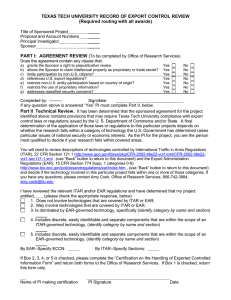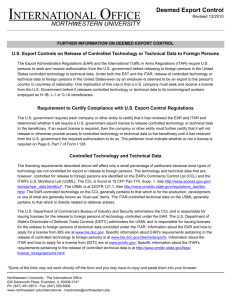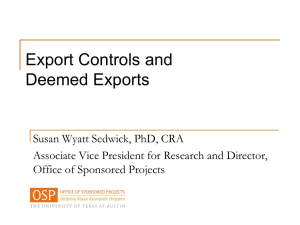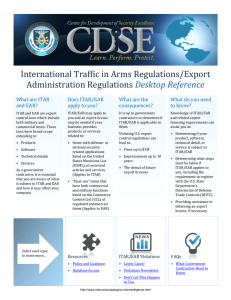ExportControls.ppt
advertisement
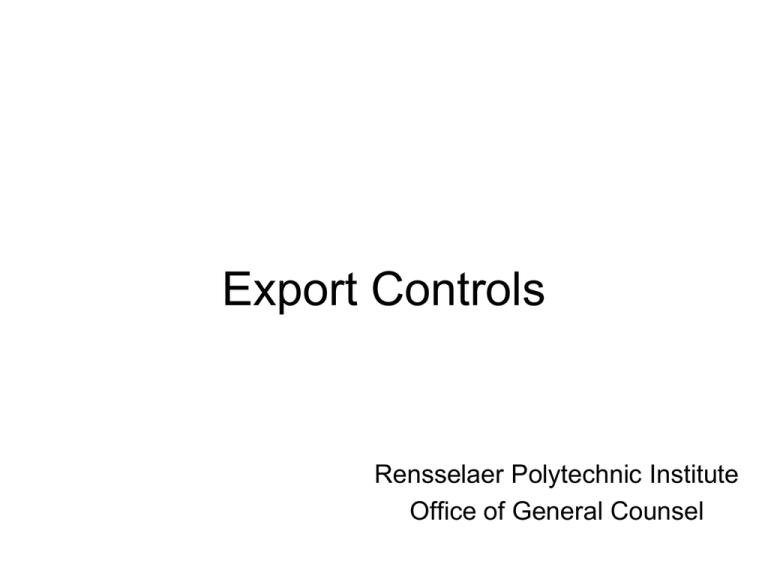
Export Controls Rensselaer Polytechnic Institute Office of General Counsel What are export controls? • U.S. laws that regulate the distribution to foreign nationals and foreign countries of strategically important technology, services and information for reasons of foreign policy and national security. • Export control laws apply to ALL activities – not just sponsored research projects. 2 What Is An Export? • Physical shipment of goods or items; • Electronic or digital transmission of goods or items; • Release of specific technical data to any foreign national; • Access by a foreign national of any covered technology. 3 Export Control Laws Commerce Department State Department Treasury Department Export Administration Act Arms Export Control Act Trading with the Enemy Act, Int’l Emergency Economic Powers Act, & Others Export Administration Regulations (“EAR”) 15 C.F.R. Parts 700-799 International Traffic in Arms Regulations (“ITAR”) 22 C.F.R. Parts 120-130 Iraq Sanctions Regulations, Terrorism Sanctions Regulations, & Others 31 C.F.R. Parts 500-599 Commerce Control List U.S. Munitions List List of Specially Designated Nationals & Blocked Persons 4 Categories – EAR (dual-use) • 0-Nuclear Materials, Facilities & Equipment (and Misc. Items) • 1-Materials, Chemicals, Microorganisms, and Toxins • 2-Materials Processing • 3-Electronics Design, Development and Production • 4-Computers • 5-Telecommunications and Information Security • 6-Sensors and Lasers • 7-Navigation and Avionics • 8-Marine • 9-Propulsion Systems, Space Vehicles and Related Equipment 5 Categories – ITAR (military) • I-Firearms, Close Assault Weapons and Combat Shotguns • II-Guns and Armament • III-Ammunition/Ordnance • IV-Launch Vehicles, Guided Missiles, Ballistic Missiles, Rockets, Torpedoes, Bombs and Mines • V-Explosives and Energetic Materials, Propellants, Incendiary Agents and Their Constituents • VI-Vessels of War and Special Naval Equipment • VII-Tanks and Military Vehicles • VIII-Aircraft and Associated Equipment • IX-Military Training Equipment • X-Protective Personnel Equipment 6 Categories – ITAR (military) • XI-Military Electronics • XII-Fire Control, Range Finder, Optical and Guidance and Control Equipment • XIII-Auxiliary Military Equipment • XIV-Toxicological Agents, Including Chemical Agents, Biological Agents, and Associated Equipment • XV-Spacecraft Systems and Associated Equipment • XVI-Nuclear Weapons, Design and Testing Related Items • XVII-Classified Articles, Technical Data and Defense Services Not Otherwise Enumerated • XVIII-Directed Energy Weapons • XIX-Reserved • XX-Submersible Vessels, Oceanographic and Associated Equipment • XXI-Miscellaneous Articles 7 Differences Between ITAR and EAR • ITAR: – Covers military items (munitions/defense articles); – Includes most space related technologies due to application to missile technology; – Includes technical data related to defense articles and services (furnishing technical assistance including design, engineering and use of defense articles); – Very strict, not much latitude, few exemptions. 8 Differences Between ITAR and EAR (cont.) • EAR: – Regulates “dual use” items - items designated for commercial purposes but that can have military applications (computers, pathogens, civilian aircraft, etc.); – Covers goods, test equipment, materials and the technology (technical data and technical assistance) and software; – Commerce Department easier to work with – more exemptions available. 9 OFAC Restrictions • OFAC prohibits the transfer of anything of value and the provision of services to countries subject to U.S. sanction programs, boycotts, etc. without a license. • Sanctions are complicated and vary across countries. • Examples: conducting surveys and interviews in boycotted countries; providing marketing and business services to persons in boycotted countries. Once, even editing by US citizen of a technical article originating in an embargoed country was deemed a violation (IEEE example) 10 OFAC Restrictions by Country Balkans, Belarus, Burma, Cote d’Ivoire, Cuba, Democratic Republic of The Congo, Iran, Iraq, Former Liberian Regime of Charles Taylor, North Korea, Sudan, Syria and Zimbabwe. For full, up to date listing, see OFAC website: http://www.treas.gov/offices/enforcement/ofac 11 Deemed Exports • Export controls cover transfers of goods and technology within the U.S. to a foreign national who is not a U.S. citizen or permanent resident (“green card” holder); • Applies to technology transfers under the EAR and ITAR’s technical data and defense services; • Applies to research assistants, students, visiting foreign researchers, or even faculty who do not yet have green cards. 12 Deemed Exports (cont.) • In the absence of an exclusion, a license must be obtained from Commerce or State to share controlled technical information with a foreign person in the U.S. or abroad. • Methods of disclosure include: – Fax – Telephone discussions – E-mail communications – Computer data disclosure – Face-to-face discussions – Training sessions – Tours which involve visual inspections 13 Export Control Exclusions License Requirement for Dissemination of Information does not apply if one of four exclusions applies: 1. 2. 3. 4. Public Domain Exclusion (ITAR, EAR)* Education Exclusion (ITAR, EAR) Fundamental Research Exclusion (ITAR, EAR)* Employment Exclusion (ITAR only) *Under the ITAR, the Fundamental Research Exclusion is a subset of the Public Domain Exclusion 14 Public Domain Exclusion (ITAR, EAR) Export controls do not apply to information and research results already published and publicly available from: – Libraries, bookstores, or newsstands; – Trade shows, meetings, seminars in the U.S. open to the public; – Published in certain patent applications; – Websites accessible to the public; – Courses listed in a university catalog of a general nature. 15 Education Exclusion (ITAR, EAR) • ITAR: No license is required to share with foreign nationals “information concerning general scientific, mathematical or engineering principles commonly taught in universities or information in the public domain”. • EAR is similar but pertains to materials included in courses found in the course catalogs of accredited institutions. • Students using controlled equipment to conduct research should be registered for a research credit class. 16 Fundamental Research Exclusion (ITAR, EAR) • No license is required to disclose to foreign nationals information which is “published and which is generally accessible or available to the public [through, for example] fundamental research in science and engineering ON SITE at US universities where the resulting information is ordinarily published and shared broadly in the scientific community”. • NOTE: ITAR states “published” rather than “ordinarily published”. 17 Fundamental Research Exclusion (ITAR, EAR) (cont.) • The Exclusion is destroyed if the University accepts any contract grant that: – Forbids or requires pre-approval for the participation of foreign nationals; – Gives the sponsor a right to approve publications resulting from the research; or – Otherwise operates to forbid participation in research and/or access to and disclosure of research results. • This includes “side deals” that may be made outside the terms of the award. 18 Employment Exclusion (ITAR) No license is required to share covered technical data with a foreign national who: – Is not a national of a prohibited country; – Is a full-time, bona fide employee; – Has a permanent address in the U.S. while employed; and – Agrees in writing not to share covered technical data with any foreign nationals. 19 Issues of Concern even if Exclusions Apply • Research projects directly with non-embargoed foreign persons or entities (if Fundamental Research, must PUBLISH) • Proprietary (non-public) information received from third parties (e.g. NDA, MTA) is not encompassed by exceptions. This can: – create a prohibited re-export to a foreign national even if the project is fundamental research – “taint” the project deliverable • Delivery of controlled equipment or information to recipients outside the US (or by email attachment) is not covered as well • Travel to embargoed countries • Travel to non-embargoed countries carrying controlled information or items. 20 Special Rules for Laptops (and GPS devices) Laptop Exclusion: • Excluding embargoed countries, faculty who wish to take their laptops out of the country to use in a university project that qualifies as fundamental research may be able to do so under the license exception for temporary export (TMP) if the laptop meets the requirement for “tools of trade” and is under the control of the faculty member (15 CFR Part 740.9) • BUT the laptop must remain within the person’s reasonable control – does not include, for instance, leaving the laptop in a hotel room while going out to dinner. 21 Use of EAR-Controlled Equipment (Old Rule) • There are no express exclusions that allow foreign persons to use controlled equipment or software without a license. • Most universities historically relied on: – The fundamental research exclusion, on the ground that using equipment is part and parcel of conducting fundamental research and/or – The education exclusion when the program of instruction required using equipment. 22 Use of EAR-Controlled Equipment (Recent History) • BIS Report in 2004 criticized university handling of controlled equipment and claimed that fundamental research exception did not extend to use of controlled equipment • Issued proposed regulation which provided that any one of the following would qualify as “use” of controlled equipment which would require a license: – Operation – Installation – Maintenance – Repair – Overhaul or 23 – Refurbishing Use of EAR-Controlled Equipment – New Rule - Firestorm of criticism from universities and industry. BIS responded on 5/31/06 by withdrawing the harsh standard on use - New definition of “use” – needs ALL SIX of the following activities: – Operation – Installation – Maintenance – Repair – Overhaul and – Refurbishing 24 Use of EAR-Controlled Equipment (cont.) • REASON: “The totality of these (listed) activities would provide the foreign national with enough knowledge to replicate or improve the performance of the controlled item. As such all of the activities listed in the definition of “use” are required to trigger a license requirement.” 25 Use of ITAR-Controlled Equipment • Not prohibited – dissemination of basic marketing information on the function or purpose, or general systems descriptions, of defense articles – Unclassified information about a defense article that is information or software concerning general scientific, mathematical or engineering principles currently in the public domain • Otherwise NO EXCEPTIONS 26 Technology Control Plans • Describes safeguards for protecting controlled technology; – IT access – Building access – Data access. • Represents a commitment to a compliance program; 27 Technology Control Plans (cont.) • Physical security plan – locked labs, access control, visitor logs, badges, etc. • Information security plan – IT access, password control, firewalls, data discussions, clean desk policy, data discard/return; • Personnel screening – review of denied persons lists, background checks; • Training and awareness (written memo is advisable); • Self-assessment – corrective actions. 28 Administrative Penalties for Noncompliance • Termination of export privileges (EAR and ITAR); • Suspension and/or debarment from government contracting (EAR and ITAR); • Voluntary disclosure of violations serves a a “mitigating factor” in deciding penalties. 29 Penalties for EAR Violations/Noncompliance • Criminal (willful violations): – Up to $1 million for the University or company; – Up to $250K per violation for individuals and/or up to 10 years in prison. • Civil: – Up to $12K per violation for individuals and the University/corporations. 30 Penalties for ITAR Violations/Noncompliance • Criminal (willful violations): – Up to $1 million for the University or company; – Up to $1 million per violation for individuals and/or up to 10 years in prison. • Civil: – Up to $500K per violation for individuals and the University or company. 31 Penalties for OFAC Violations/Noncompliance • Criminal (willful violations): – Fine of no more than $1M for companies – Fine of no more than $100K for individuals (including corporate officers) and/or 10 years imprisonment • Civil penalties: – Fine up to $55K for each violation by any person. 32 New development – Issuance of Deemed Export Advisory Committee Report 12/07 • http://tac.bis.doc.gov/2007/deacreport.pdf • The DEAC was appointed to review current deemed export policy and ensure it continues to protect the national security of the United States while promoting continued leadership in technological innovation by U.S. academic institutions and industry. • The report concluded that the current deemed export policy and regulations no longer effectively served their intended purposes and proposed a new deemed export licensing process that the committee believed will enhance both national security and economic competitiveness. • Recommendations: – “higher walls around fewer items”; – annual “sunset” review of controlled items on the list; – establish “Trusted Entities” and a streamlined licensing process. 33
